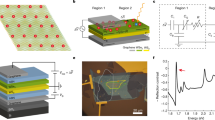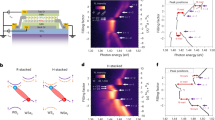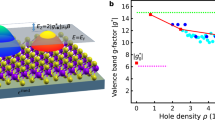Abstract
Moiré superlattices formed from transition metal dichalcogenides support a variety of quantum electronic phases that are highly tunable using applied electromagnetic fields. While the valley degree of freedom affects optoelectronic properties in the constituent transition metal dichalcogenides, it has yet to be fully explored in moiré systems. Here we establish twisted double-bilayer WSe2 as an experimental platform to study electronic correlations within Γ-valley moiré bands. Through local and global electronic compressibility measurements, we identify charge-ordered phases at multiple integer and fractional moiré fillings. By measuring the magnetic field dependence of their energy gaps and the chemical potential upon doping, we reveal spin-polarized ground states with spin-polaron quasiparticle excitations. In addition, an applied displacement field induces a metal–insulator transition driven by tuning between Γ- and K-valley moiré bands. Our results demonstrate control over the spin and valley character of the correlated ground and excited states in this system.
This is a preview of subscription content, access via your institution
Access options
Access Nature and 54 other Nature Portfolio journals
Get Nature+, our best-value online-access subscription
$29.99 / 30 days
cancel any time
Subscribe to this journal
Receive 12 print issues and online access
$259.00 per year
only $21.58 per issue
Buy this article
- Purchase on Springer Link
- Instant access to full article PDF
Prices may be subject to local taxes which are calculated during checkout



Similar content being viewed by others
Data availability
Source data are provided with this paper. Additional data that support the findings of this study are available from the corresponding author upon reasonable request.
Code availability
The codes that support the findings of this study are available from the corresponding author upon reasonable request.
References
Andrei, E. Y. & MacDonald, A. H. Graphene bilayers with a twist. Nat. Mater. 19, 1265–1275 (2020).
Balents, L., Dean, C. R., Efetov, D. K. & Young, A. F. Superconductivity and strong correlations in moiré flat bands. Nat. Phys. 16, 725–733 (2020).
Kennes, D. M. et al. Moiré heterostructures as a condensed-matter quantum simulator. Nat. Phys. 17, 155–163 (2021).
Wu, F., Lovorn, T., Tutuc, E. & MacDonald, A. Hubbard model physics in transition metal dichalcogenide moiré bands. Phys. Rev. Lett. 121, 026402 (2018).
Zhang, Y., Yuan, N. F. Q. & Fu, L. Moire quantum chemistry: charge transfer in transition metal dichalcogenide superlattices. Phys. Rev. B 102, 201115 (2020).
Wu, F., Lovorn, T., Tutuc, E., Martin, I. & MacDonald, A. Topological insulators in twisted transition metal dichalcogenide homobilayers. Phys. Rev. Lett. 122, 086402 (2019).
Angeli, M. & MacDonald, A. H. Γ valley transition metal dichalcogenide moiré bands. Proc. Natl Acad. Sci. USA 118, e2021826118 (2021).
Zhang, Y., Liu, T. & Fu, L. Electronic structures, charge transfer, and charge order in twisted transition metal dichalcogenide bilayers. Phys. Rev. B 103, 155142 (2021).
Regan, E. C. et al. Mott and generalized Wigner crystal states in WSe2/WS2 moiré superlattices. Nature 579, 359–363 (2020).
Tang, Y. et al. Simulation of Hubbard model physics in WSe2/WS2 moiré superlattices. Nature 579, 353–358 (2020).
Wang, L. et al. Correlated electronic phases in twisted bilayer transition metal dichalcogenides. Nat. Mater. 19, 861–866 (2020).
Li, T. et al. Charge-order-enhanced capacitance in semiconductor moiré superlattices. Nat. Nanotechnol. 16, 1068–1072 (2021).
Li, T. et al. Quantum anomalous Hall effect from intertwined moiré bands. Nature 600, 641–646 (2021).
Xu, Y. et al. A tunable bilayer Hubbard model in twisted WSe2. Nat. Nanotechnol. 17, 934–939 (2022).
Xu, Y. et al. Correlated insulating states at fractional fillings of moiré superlattices. Nature 587, 214–218 (2020).
Chu, Z. et al. Nanoscale conductivity imaging of correlated electronic states in WSe2/WS2 moiré superlattices. Phys. Rev. Lett. 125, 186803 (2020).
Li, H. et al. Imaging moiré flat bands in three-dimensional reconstructed WSe2/WS2 superlattices. Nat. Mater. 20, 945–950 (2021).
Huang, X. et al. Correlated insulating states at fractional fillings of the WS2/WSe2 moiré lattice. Nat. Phys. 17, 715–719 (2021).
Tang, Y. et al. Dielectric catastrophe at the Wigner–Mott transition in a moiré superlattice. Nat. Commun. 13, 4271 (2022).
Ghiotto, A. et al. Quantum criticality in twisted transition metal dichalcogenides. Nature 597, 345–349 (2021).
Li, T. et al. Continuous Mott transition in semiconductor moiré superlattices. Nature 597, 350–354 (2021).
Zhang, M. et al. Tuning quantum phase transitions at half filling in 3L MoTe2/WSe2 moiré superlattices. Phys. Rev. X 12, 041015 (2022).
Pan, H., Wu, F. & Das Sarma, S. Quantum phase diagram of a Moiré–Hubbard model. Phys. Rev. B 102, 201104 (2020).
Hu, N. C. & MacDonald, A. H. Competing magnetic states in transition metal dichalcogenide moire materials. Phys. Rev. B 104, 214403 (2021).
Wang, X. et al. Light-induced ferromagnetism in moiré superlattices. Nature 604, 468–473 (2022).
Tang, Y. et al. Evidence of frustrated magnetic interactions in a Wigner–Mott insulator. Nat. Nanotechnol. 18, 233–237 (2023).
Magorrian, S. J. et al. Multifaceted moire superlattice physics in twisted WSe2 bilayers. Phys. Rev. B 104, 125440 (2021).
Vitale, V., Atalar, K., Mostofi, A. A. & Lischner, J. Flat band properties of twisted transition metal dichalcogenide homo- and heterobilayers of MoS2, MoSe2, WS2, and WSe2. 2D Mater. 8, 045010 (2021).
Xian, L. et al. Realization of nearly dispersionless bands with strong orbital anisotropy from destructive interference in twisted bilayer MoS2. Nat. Commun. 12, 5644 (2021).
Shabani, S. et al. Deep moiré potentials in twisted transition metal dichalcogenide bilayers. Nat. Phys. 17, 720–725 (2021).
Mak, K. F., Lee, C., Hone, J., Shan, J. & Heinz, T. F. Atomically thin MoS2: a new direct-gap semiconductor. Phys. Rev. Lett. 105, 136805 (2010).
Xu, X., Yao, W., Xiao, D. & Heinz, T. F. Spin and pseudospins in layered transition metal dichalcogenides. Nat. Phys. 10, 343–350 (2014).
Movva, H. C. et al. Tunable Γ − K valley populations in hole-doped trilayer WSe2. Phys. Rev. Lett. 120, 107703 (2018).
Zhang, S.-S., Zhu, W. & Batista, C. D. Pairing from strong repulsion in triangular lattice Hubbard model. Phys. Rev. B 97, 140507 (2018).
Morera, I., Bohrdt, A., Ho, W. W. & Demler, E. Attraction from frustration in ladder systems. Preprint at http://arxiv.org/abs/2106.09600 (2021).
Davydova, M., Zhang, Y. & Fu, L. Itinerant spin polaron and metallic ferromagnetism in semiconductor moire superlattices. Preprint at http://arxiv.org/abs/2206.01221 (2023).
Zhu, Z. Y., Cheng, Y. C. & Schwingenschlögl, U. Giant spin-orbit-induced spin splitting in two-dimensional transition-metal dichalcogenide semiconductors. Phys. Rev. B 84, 153402 (2011).
Shi, Q. et al. Bilayer WSe2 as a natural platform for interlayer exciton condensates in the strong coupling limit. Nat. Nanotechnol. 17, 577–582 (2022).
Liu, G.-B., Xiao, D., Yao, Y., Xu, X. & Yao, W. Electronic structures and theoretical modelling of two-dimensional group-VIB transition metal dichalcogenides. Chem. Soc. Rev. 44, 2643–2663 (2015).
Wilson, N. R. et al. Determination of band offsets, hybridization, and exciton binding in 2D semiconductor heterostructures. Sci. Adv. 3, e1601832 (2017).
An, L. et al. Interaction effects and superconductivity signatures in twisted double-bilayer WSe2. Nanoscale Horiz. 5, 1309–1316 (2020).
Aivazian, G. et al. Magnetic control of valley pseudospin in monolayer WSe2. Nat. Phys. 11, 148–152 (2015).
Gustafsson, M. V. et al. Ambipolar Landau levels and strong band-selective carrier interactions in monolayer WSe2. Nat. Mater. 17, 411–415 (2018).
Movva, H. C. et al. Density-dependent quantum Hall states and Zeeman splitting in monolayer and bilayer WSe2. Phys. Rev. Lett. 118, 247701 (2017).
Nicholas, R. J., Haug, R. J., Klitzing, K. V. & Weimann, G. Exchange enhancement of the spin splitting in a GaAs-GaxAl1−xAs heterojunction. Phys. Rev. B 37, 1294–1302 (1988).
Tutuc, E., Melinte, S. & Shayegan, M. Spin polarization and g factor of a dilute GaAs two-dimensional electron system. Phys. Rev. Lett. 88, 036805 (2002).
Eisenstein, J. P., Pfeiffer, L. N. & West, K. W. Negative compressibility of interacting two-dimensional electron and quasiparticle gases. Phys. Rev. Lett. 68, 674–677 (1992).
Eisenstein, J. P., Pfeiffer, L. N. & West, K. W. Compressibility of the two-dimensional electron gas: measurements of the zero-field exchange energy and fractional quantum Hall gap. Phys. Rev. B 50, 1760–1778 (1994).
Yu, J. et al. Correlated Hofstadter spectrum and flavour phase diagram in magic-angle twisted bilayer graphene. Nat. Phys. 18, 825–831 (2022).
Shi, Q. et al. Odd- and even-denominator fractional quantum Hall states in monolayer WSe2. Nat. Nanotechnol. 15, 569–573 (2020).
Peng, H., Yang, Z.-H., Perdew, J. P. & Sun, J. Versatile van der Waals density functional based on a meta-generalized gradient approximation. Phys. Rev. X 6, 041005 (2016).
Kresse, G. & Furthmüller, J. Efficient iterative schemes for ab initio total-energy calculations using a plane-wave basis set. Phys. Rev. B 54, 11169–11186 (1996).
Acknowledgements
We acknowledge helpful conversations with A.H. MacDonald. We thank T. Heinz, A. O’Beirne and H.B. Ribeiro for their assistance with second-harmonic generation measurements. Experimental work was primarily supported by the National Science Foundation (Grant no. NSF-DMR-2103910). B.E.F. acknowledges an Alfred P. Sloan Foundation Fellowship and a Cottrell Scholar Award. The work at the Massachusetts Institute of Technology is supported by a Simons Investigator Award from the Simons Foundation. L.F. is partly supported by the David and Lucile Packard Foundation. K.W. and T.T. acknowledge support from the Japan Society for the Promotion of Science Grants-in-Aid for Scientific Research (JSPS KAKENHI, Grant nos. 19H05790, 20H00354 and 21H05233). B.A.F. acknowledges a Stanford Graduate Fellowship. Part of this work was performed at the Stanford Nano Shared Facilities, supported by the National Science Foundation (Award no. ECCS-2026822).
Author information
Authors and Affiliations
Contributions
B.A.F, J.Y. and B.E.F. designed and conducted the scanning SET experiments. B.A.F. and B.E.F. designed and conducted the dual-gate capacitance experiments. T.D., Y.Z. and L.F. conducted theoretical calculations. B.A.F. fabricated the samples, with help from C.R.K. K.W. and T.T. provided hBN crystals. All authors participated in analysis of the data and writing of the paper.
Corresponding author
Ethics declarations
Competing interests
The authors declare no competing interests.
Peer review
Peer review information
Nature Materials thanks Emanuel Tutuc and the other, anonymous, reviewer(s) for their contribution to the peer review of this work.
Additional information
Publisher’s note Springer Nature remains neutral with regard to jurisdictional claims in published maps and institutional affiliations.
Supplementary information
Supplementary Information
Supplementary Sections 1–13, Figs. 1–22 and Tables 1 and 2.
Source data
Source Data Fig. 1
Source data for Fig. 1.
Source Data Fig. 2
Source data for Fig. 2.
Source Data Fig. 3
Source data for Fig. 3.
Rights and permissions
Springer Nature or its licensor (e.g. a society or other partner) holds exclusive rights to this article under a publishing agreement with the author(s) or other rightsholder(s); author self-archiving of the accepted manuscript version of this article is solely governed by the terms of such publishing agreement and applicable law.
About this article
Cite this article
Foutty, B.A., Yu, J., Devakul, T. et al. Tunable spin and valley excitations of correlated insulators in Γ-valley moiré bands. Nat. Mater. 22, 731–736 (2023). https://doi.org/10.1038/s41563-023-01534-z
Received:
Accepted:
Published:
Issue Date:
DOI: https://doi.org/10.1038/s41563-023-01534-z
This article is cited by
-
Observation of spin polarons in a frustrated moiré Hubbard system
Nature Physics (2024)
-
The interplay of field-tunable strongly correlated states in a multi-orbital moiré system
Nature Physics (2024)
-
Kinetic magnetism in triangular moiré materials
Nature (2023)
-
Hofstadter states and re-entrant charge order in a semiconductor moiré lattice
Nature Physics (2023)



